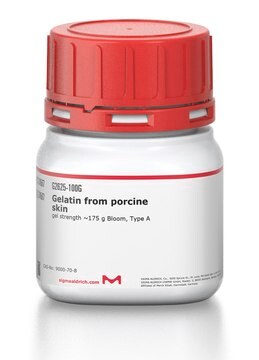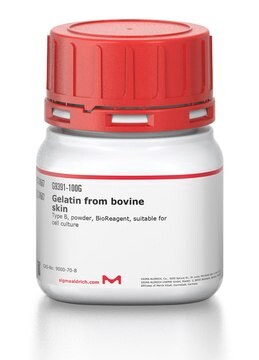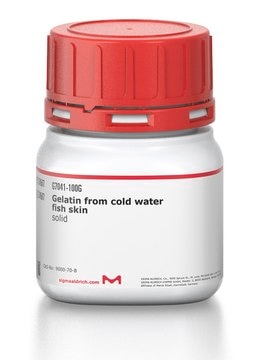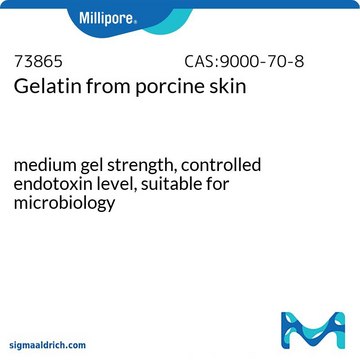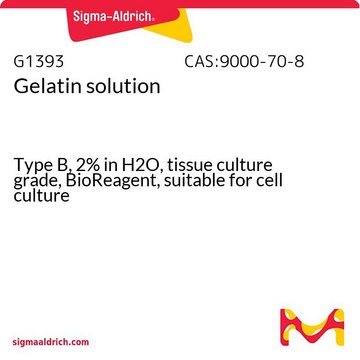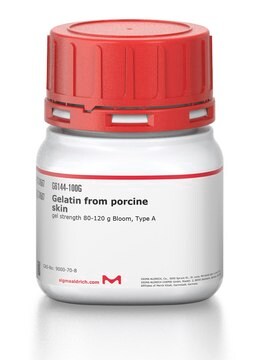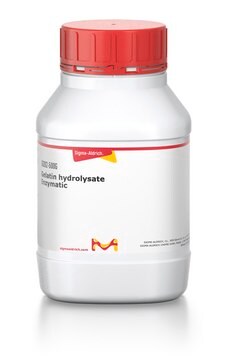48722
Gelatin from porcine skin
medium gel strength, suitable for microbiology
Synonim(y):
Gelatine, hydrolyzed collagen, collagen hydrolysate, gelatine hydrolysate
About This Item
Polecane produkty
pochodzenie biologiczne
Porcine
Poziom jakości
sterylność
non-sterile
Postać
powder
jakość
medium gel strength
opakowanie
bottle of 100 g
bottle of 500 g
pozostałość po prażeniu
≤2%
strata
≤15% loss on drying
kolor
light yellow
pH
4.0-6.0 (25 °C, 67 mg/mL in H2O)
siła żelu
165-195 g Bloom (67 mg/ml water)
rozpuszczalność
H2O: 67 mg/mL at 50 °C, slightly hazy, slightly yellow
ślady anionów
chloride (Cl-): ≤3000 mg/kg
ślady kationów
Ca: ≤2000 mg/kg
Cd: ≤5 mg/kg
Co: ≤5 mg/kg
Cr: ≤10 mg/kg
Cu: ≤50 mg/kg
Fe: ≤50 mg/kg
K: ≤500 mg/kg
Mg: ≤500 mg/kg
Mn: ≤5 mg/kg
Na: ≤5000 mg/kg
Ni: ≤5 mg/kg
Pb: ≤5 mg/kg
Zn: ≤10 mg/kg
Zastosowanie
microbiology
Szukasz podobnych produktów? Odwiedź Przewodnik dotyczący porównywania produktów
Opis ogólny
Gelatin is a heterogeneous mixture of water-soluble proteins of high average molecular masses present in collagen. Proteins are extracted by boiling the relevant skin, tendons, ligaments, bones, etc., in water. Type A gelatin is derived from acid-cured tissue, and Type B from lime-cured tissue.
The Bloom number, determined by the Bloom gelometer, is an indication of the strength of a gel formed from a solution of the known concentration. The Bloom number is proportional to the average molecular mass. Bloom numbers of porcine skin Gelatin vary from 90 to 300 g. This product has a gel strength of 180.
Zastosowanie
Komponenty
Przestroga
Uwaga dotycząca przygotowania
Kod klasy składowania
11 - Combustible Solids
Klasa zagrożenia wodnego (WGK)
nwg
Środki ochrony indywidualnej
Eyeshields, Gloves, type N95 (US)
Wybierz jedną z najnowszych wersji:
Masz już ten produkt?
Dokumenty związane z niedawno zakupionymi produktami zostały zamieszczone w Bibliotece dokumentów.
Klienci oglądali również te produkty
Nasz zespół naukowców ma doświadczenie we wszystkich obszarach badań, w tym w naukach przyrodniczych, materiałoznawstwie, syntezie chemicznej, chromatografii, analityce i wielu innych dziedzinach.
Skontaktuj się z zespołem ds. pomocy technicznej

